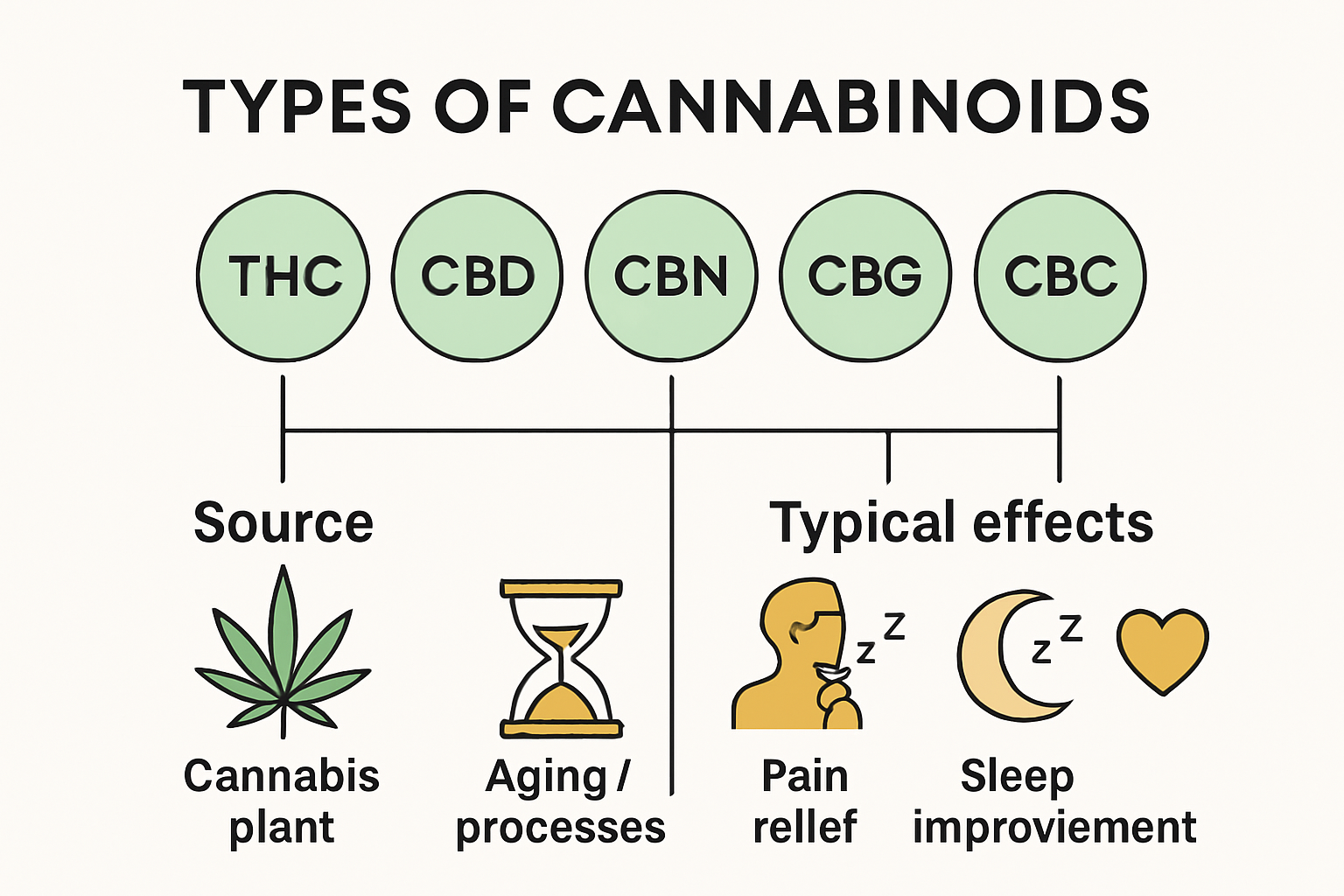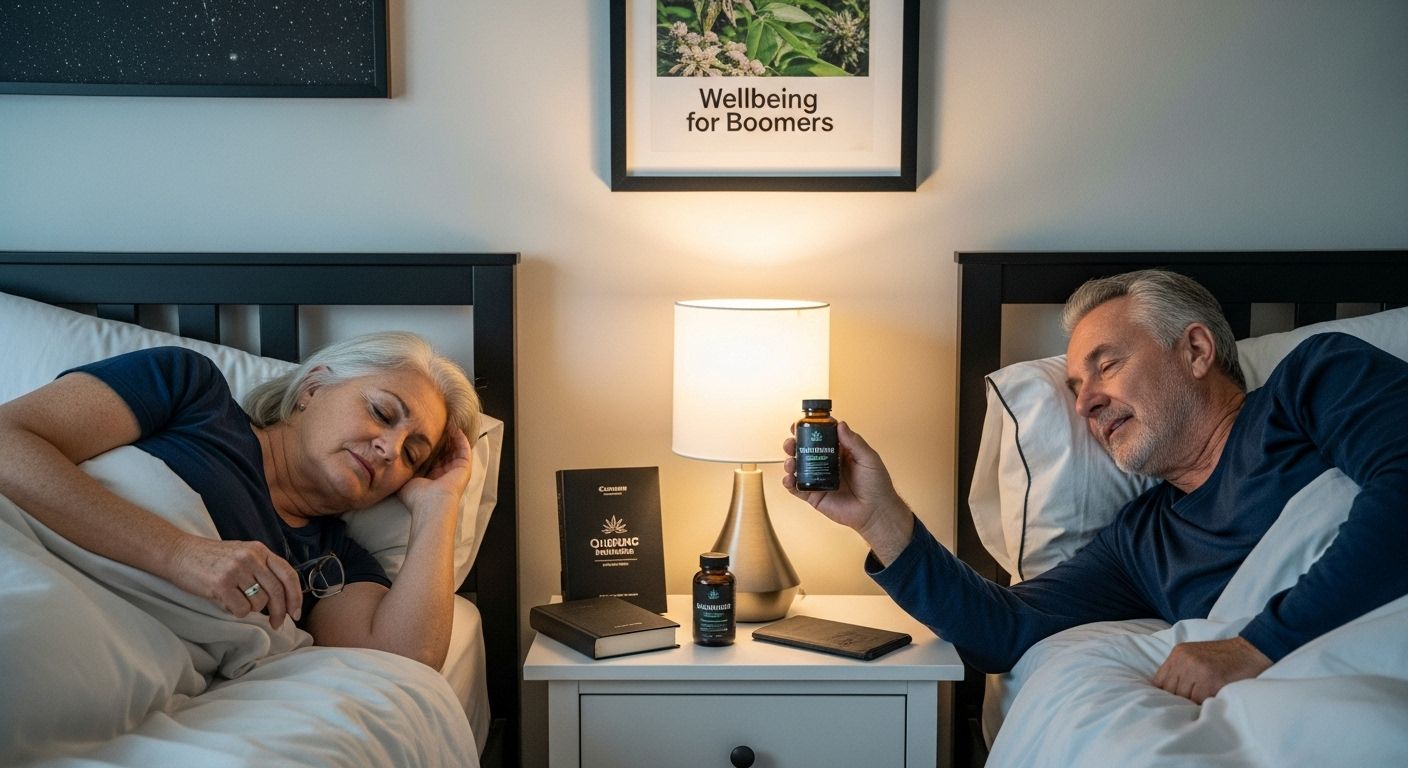Curious about the benefits of Cannabinoids available in Canada? Many Boomers and mature Canadians are looking for natural ways to stay well as they age. Did you know that over 60 percent of Canadian seniors interested in using cannabinoids for managing pain or improving sleep? Most imagine it is all about getting high or breaking the law. The real surprise is that cannabinoids can play a subtle and legal role in wellbeing, with effects that go far beyond stereotypes.
Table of Contents
- What Are Cannabinoids And How They Work
- Key Cannabinoids Found In Cannabis
- Cannabinoids And Wellbeing For Boomers
Quick Summary
| Takeaway | Explanation |
|---|---|
| Cannabinoids interact with the endocannabinoid system. | They help regulate various bodily functions through receptors in the brain and body, influencing processes such as memory and pleasure. |
| THC and CBD are primary cannabinoids. | THC is psychoactive, affecting mood and perception, while CBD provides therapeutic benefits without intoxication. |
| Cannabinoids may alleviate age-related wellness challenges. | Research suggests potential benefits in managing chronic pain and improving sleep quality for older adults. |
| Consult healthcare professionals before use. | Individual health profiles and existing conditions can significantly affect cannabinoid interactions, making professional guidance essential. |
| Start low and go slow with dosing. | Initiating cannabinoid use with minimal doses allows for monitoring individual responses and adjusting accordingly based on effects. |
What Are Cannabinoids and How They Work
Cannabinoids contain a complex group of chemical compounds that interact with the human body in numerous ways. These naturally occurring compounds influence and affect our internal systems in different ways we’re just beginning to understand.
The Science Behind Cannabinoid Interactions
Understanding the effect of cannabinoids means understanding the endocannabinoid system (ECS), a sophisticated biological network that helps regulate various bodily processes. Research from the National Institute on Drug Abuse reveals that cannabinoids interact with specific receptors in the brain and body, primarily CB1 and CB2 receptors. You have Cannabinoid receptors throughout your body and brain. The interactions with CB1 and CB2 receptors influence critical processes such as memory, pleasure, thinking, concentration, movement, and sensory perception.
The two primary types of cannabinoids are endocannabinoids (produced naturally within the body) and phytocannabinoids (derived from plants). Tetrahydrocannabinol (THC) is known for its psychoactive properties, while Cannabidiol (CBD) offers non-intoxicating effects that have captured significant scientific interest.
Mechanisms of Action
According to a comprehensive medical review, cannabinoids modulate neurotransmitter release, creating a complex interaction within the body’s biological systems. This modulation can affect various physiological processes, potentially influencing pain perception, mood regulation, and immune system responses.
The way cannabinoids work is remarkably nuanced. They bind to cannabinoid receptors throughout the body, triggering specific cellular responses. This interaction is not a simple on-off switch but a delicate communication process that can vary depending on individual biochemistry, dosage, and specific cannabinoid compounds.
Understanding these intricate interactions helps explain why cannabinoids have such diverse potential effects. Some individuals report experiencing relaxation, while others might notice changes in pain perception or mood stability. Learn more about our guide on cannabinoid interactions.
Importantly, each person’s experience with cannabinoids can be unique. Factors such as individual physiology, existing health conditions, and genetic makeup all play significant roles in how these compounds are processed and experienced. This complexity underscores the importance of personalized approaches and professional guidance when exploring cannabinoid use.
Research continues to uncover the intricate ways cannabinoids interact with our biological systems, promising exciting insights into potential therapeutic applications. While much remains to be understood, the current scientific landscape suggests these compounds hold remarkable potential for supporting overall wellness and addressing various health challenges.
Key Cannabinoids Found in Cannabis
Cannabis contains a remarkable array of chemical compounds known as cannabinoids, each with unique properties and potential interactions within the human body. Understanding these diverse compounds provides valuable insights into their potential effects and applications.

Primary Cannabinoids
Research from the National Cancer Institute highlights two prominent cannabinoids that have garnered significant scientific attention: Tetrahydrocannabinol (THC) and Cannabidiol (CBD). THC is well-known for its psychoactive properties, creating the characteristic ‘high’ associated with cannabis use. In contrast, CBD has emerged as a non-intoxicating compound with potential therapeutic applications.
THC primarily interacts with CB1 receptors in the brain, influencing mood, perception, and cognitive function. Its effects can include relaxation, altered sensory perception, and potential pain management. CBD, however, works differently by interacting with multiple receptor systems, potentially offering anti-inflammatory and calming effects without producing intoxication.
Lesser-Known Cannabinoid Compounds
Beyond THC and CBD, cannabis contains a diverse range of lesser-known but equally fascinating cannabinoids. According to a comprehensive NIH study, compounds like Cannabinol (CBN), Cannabigerol (CBG), and Cannabichromene (CBC) each present unique potential.
CBN, typically formed when THC ages, is associated with potential sedative effects. Cannabigerol (CBG) is often called the ‘mother cannabinoid’ because other cannabinoids are synthesized from its acidic form. CBC shows promise in potentially supporting neurological health and managing inflammation.
To help readers compare the most well-known and lesser-known cannabinoids discussed, here is a summary table outlining their key characteristics and potential effects.
| Cannabinoid | Psychoactive? | Key Properties | Noted Potential Benefits |
|---|---|---|---|
| THC | Yes | Interacts mainly with CB1 receptors; responsible for ‘high’ | Relaxation, pain management, altered perception |
| CBD | No | Non-intoxicating; interacts with multiple receptor systems | Anti-inflammatory, calming, may ease anxiety |
| CBN | Mild | Formed as THC ages; weakly psychoactive | Potential sedative effects, sleep support |
| CBG | No | ‘Mother cannabinoid’; precursor to others | Possible anti-inflammatory, neuroprotective |
| CBC | No | Minor cannabinoid; non-intoxicating | Potential neurological health and inflammation management |
Potential Therapeutic Implications
The complexity of cannabinoids extends far beyond simple classification. Each compound interacts with the body’s endocannabinoid system in nuanced ways, suggesting potential applications across various health domains. Explore our detailed guide on cannabinoid isolates to understand these intricate interactions.
Researchers continue to investigate how these compounds might support wellness. While definitive medical claims require extensive research, early studies suggest cannabinoids could play roles in managing pain, supporting sleep regulation, and potentially mitigating stress.
It is crucial to approach cannabinoid exploration with an informed, personalized perspective. Individual responses can vary significantly based on physiology, existing health conditions, and specific cannabinoid profiles. Consulting healthcare professionals remains the most responsible approach to understanding potential cannabinoid interactions.
The world of cannabinoids represents a fascinating frontier of scientific exploration. As research advances, our understanding of these compounds continues to evolve, promising exciting insights into their potential role in supporting human health and wellness.
Cannabinoids and Wellbeing for Boomers
As individuals enter their later years, exploring natural approaches to wellness becomes increasingly important. Cannabinoids represent a promising area of potential support for boomers seeking holistic strategies to maintain health and improve quality of life.
Addressing Age-Related Wellness Challenges
Research published in PubMed Central offers compelling insights into cannabinoids’ potential benefits for older adults. A comprehensive review highlights moderate evidence suggesting cannabinoids might help manage chronic pain, improve sleep quality, and enhance overall quality of life for individuals navigating age-related health challenges.
chronic pain and reduced mobility often accompany aging, making traditional pain management strategies less effective. Cannabinoids present an intriguing alternative that potentially supports comfort and movement without the harsh side effects associated with some conventional treatments. The subtle interactions within the endocannabinoid system suggest a nuanced approach to supporting bodily wellness.
Potential Support for Cognitive and Emotional Wellness
Beyond physical comfort, cannabinoids may offer potential benefits for cognitive and emotional health. Some preliminary studies suggest these compounds could support stress management, potentially helping boomers maintain emotional balance during life transitions. Learn more about comprehensive wellness strategies with cannabinoids.
It is crucial to understand that individual responses to cannabinoids vary significantly. Factors such as existing health conditions, current medications, and personal biochemistry play substantial roles in how these compounds interact with the body. Professional medical guidance remains essential when considering any new wellness approach.
Responsible Exploration and Personalized Wellness
Responsible cannabinoid exploration requires a thoughtful, informed approach. Consulting healthcare professionals, understanding potential interactions, and starting with conservative approaches are fundamental principles for boomers interested in these compounds.
The emerging research landscape suggests cannabinoids are not a universal solution but potentially valuable tools in a comprehensive wellness strategy. Individuals should approach these compounds with realistic expectations, understanding that they represent one potential component of a holistic health approach.
Modern wellness is about personalization. What works effectively for one person might differ for another. This principle holds particularly true for cannabinoids, where individual biochemistry plays a significant role in how these compounds are processed and experienced.
As scientific understanding continues to evolve, boomers have an exciting opportunity to explore innovative wellness strategies. Cannabinoids represent a fascinating frontier of potential support, offering hope for those seeking natural approaches to maintaining health and vitality during life’s later stages.

Embracing new wellness possibilities requires both curiosity and caution. By staying informed, consulting professionals, and maintaining an open yet critical perspective, boomers can navigate the promising world of cannabinoids with confidence and wisdom.
Safety Considerations for Mature Users
Safety becomes paramount when exploring cannabinoid options, particularly for boomers with existing health conditions or medication regimens. Our comprehensive market update offers insights into current best practices for safe and informed cannabinoid use.
Key safety considerations include:
- Consultation with Healthcare Professionals: Always discuss potential cannabinoid use with medical practitioners who understand your unique health profile.
- Start Low, Go Slow: Begin with minimal doses and gradually adjust based on individual response and professional guidance.
- Quality Verification: Purchase only from licensed, reputable sources that provide transparent product testing and quality assurance.
Responsible Consumption Strategies
Responsible cannabinoid consumption extends beyond legal compliance. It involves a holistic approach to personal wellness, understanding individual limits, and maintaining open communication with healthcare providers.
Individuals should consider potential interactions with existing medications, monitor personal responses, and remain attentive to any physiological changes. Keeping detailed records of dosage, frequency, and experienced effects can provide valuable insights for both personal tracking and medical discussions.
For readers exploring safe and legal cannabinoid use, the following checklist summarises essential responsible consumption strategies highlighted in this article.
| Action Step | Recommended? |
|---|---|
| Consult healthcare professional | Yes |
| Start with low doses | Yes |
| Purchase from reputable sources | Yes |
| Monitor personal responses | Yes |
| Check for medication interactions | Yes |
| Keep dosage/effect records | Yes |
| Stay updated on legal guidelines | Yes |
Education remains a powerful tool. Staying updated on current research, understanding product variations, and maintaining a critical yet open mindset helps boomers make informed decisions about cannabinoid use.
The evolving landscape of cannabinoid research and regulation demands continuous learning. What is true today might change tomorrow, making ongoing education and adaptability crucial for responsible use.
Ultimately, legal and safe cannabinoid use is about balance. It involves respecting regulatory frameworks, prioritizing personal health, and approaching wellness with thoughtfulness and care. By combining legal awareness, safety consciousness, and personal responsibility, boomers can explore the potential benefits of cannabinoids with confidence and peace of mind.
Frequently Asked Questions
What are cannabinoids?
Cannabinoids are a group of chemical compounds found in cannabis that interact with the body’s endocannabinoid system, influencing various bodily functions and processes such as pain perception and mood regulation.
What is the difference between THC and CBD?
THC (tetrahydrocannabinol) is the psychoactive component of cannabis that produces a ‘high’, while CBD (cannabidiol) is non-intoxicating and is known for its therapeutic benefits, such as anti-inflammatory and calming effects.
How can cannabinoids support wellness for boomers?
Cannabinoids may help manage age-related wellness challenges by alleviating chronic pain, improving sleep quality, and potentially supporting cognitive and emotional health during life’s transitions.
What precautions should boomers take when using cannabinoids?
Boomers should consult healthcare professionals before using cannabinoids, start with low doses to monitor individual responses, and ensure they purchase products from reputable, licensed sources to guarantee quality and safety.
Experience Personalised Wellness Solutions for Quebec Boomers
Are you seeking reliable and natural ways to manage pain, improve sleep or support your wellbeing as you age? Many readers like yourself are exploring cannabinoids for chronic pain relief, better sleep and holistic health, but often feel uncertain about quality or where to begin. With a wealth of information on the endocannabinoid system and the unique effects of THC and CBD, this guide has offered clarity. Yet, the next challenge is finding safe, effective products from a trusted Canadian source.

Take the next step with confidence. BuyMellow.com is dedicated to Canadians who want premium CBD oils, extracts and topicals delivered discreetly and legally. Our comprehensive market update explains what sets our solutions apart. Visit our homepage and explore curated products designed for mature wellness needs. Discover the difference today and make your cannabinoid journey personal and secure. See our Beginner’s Guide to CBD here. Act now to build your own path to comfort and balance.



